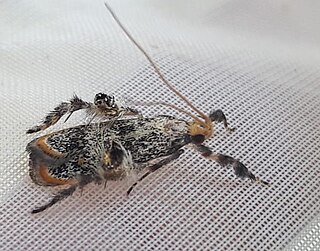Dichomeris ligyra is a species of moth in the family Gelechiidae. It was described by Edward Meyrick in 1913. It is found in Gauteng, South Africa.
Hypatima ericta is a moth in the family Gelechiidae. It was described by Edward Meyrick in 1913. It is found in Sri Lanka.
Ardozyga odorifera is a species of moth in the family Gelechiidae. It was described by Edward Meyrick in 1904. It is found in Australia, where it has been recorded from New South Wales and Queensland.
Telphusa smaragdopis is a moth of the family Gelechiidae. It is found in Costa Rica.
Battaristis emissurella is a moth of the family Gelechiidae. It was described by Francis Walker in 1864. It is found in Panama, Colombia, Suriname, Guyana and Brazil.
Thiotricha grammitis is a moth of the family Gelechiidae. It was described by Edward Meyrick in 1908. It is found in Assam, India.
Antaeotricha corvigera is a moth of the family Depressariidae first described by Edward Meyrick in 1915. It is found in Guyana and Peru.
Mothonica fluminata is a moth of the family Depressariidae. It is found in Colombia and Suriname.
Stenoma platyterma is a moth of the family Depressariidae. It is found in Guyana.

Tisis mendicella is a moth in the family Lecithoceridae. It was described by Francis Walker in 1864. It is found in Sri Lanka.
Bassarodes is a monotypic moth genus in the family Xyloryctidae. Its only species, Bassarodes siriaca, is found on the Solomon Islands. Both the genus and species were first described by Edward Meyrick in 1910.
Catoryctis subnexella is a moth in the family Xyloryctidae. It was described by Francis Walker in 1864. It is found in Australia, where it has been recorded from the Australian Capital Territory, New South Wales, South Australia and Tasmania.
Aeolanthes callidora is a moth in the family Depressariidae. It was described by Edward Meyrick in 1907 and is found in India (Assam).
Aeolanthes dicraea is a moth in the family Depressariidae. It was described by Edward Meyrick in 1908. It is found in India (Assam).
Psittacastis pictrix is a moth in the family Depressariidae. It was described by Edward Meyrick in 1921. It is found in Colombia.
Imma auxobathra is a moth in the family Immidae. It was described by Edward Meyrick in 1906. It is found on Borneo and in Nepal.
Imma chasmatica is a moth in the family Immidae. It was described by Edward Meyrick in 1906. It is found in the Indian states of Sikkim and Assam.
Imma neurota is a moth in the family Immidae. It was described by Edward Meyrick in 1906. It is found on Borneo.
Imma thyriditis is a moth in the family Immidae. It was described by Edward Meyrick in 1906. It is found on the Solomon Islands.
Imma thianthes is a moth in the family Immidae. It was described by Edward Meyrick in 1927. It is found on New Ireland and New Hanover.

